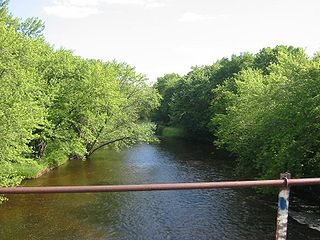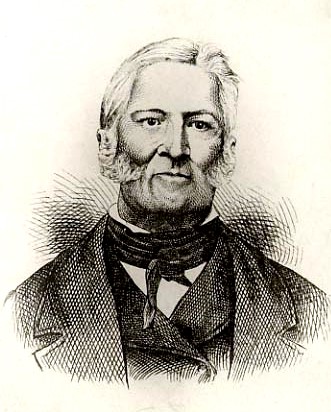
Jean-Baptiste Faribault (October 19, 1775 – August 20, 1860) was a trader with the Indians and early settler in Minnesota.

Native Americans, also known as American Indians, Indigenous Americans and other terms, are the indigenous peoples of the United States, except Hawaii. There are over 500 federally recognized tribes within the US, about half of which are associated with Indian reservations. The term "American Indian" excludes Native Hawaiians and some Alaska Natives, while Native Americans are American Indians, plus Alaska Natives of all ethnicities. Native Hawaiians are not counted as Native Americans by the US Census, instead being included in the Census grouping of "Native Hawaiian and other Pacific Islander".

Minnesota is a state in the Upper Midwest and northern regions of the United States. Minnesota was admitted as the 32nd U.S. state on May 11, 1858, created from the eastern half of the Minnesota Territory. The state has a large number of lakes, and is known by the slogan the "Land of 10,000 Lakes". Its official motto is L'Étoile du Nord.
His father, Barthélemy Faribault, a lawyer of Paris, France, settled in Canada towards the middle of the 18th century and served as military secretary to the French army in Canada. After the occupation of the country by the English, he retired to private life in Berthier and he held the office of notary public.

France, officially the French Republic, is a country whose territory consists of metropolitan France in Western Europe and several overseas regions and territories. The metropolitan area of France extends from the Mediterranean Sea to the English Channel and the North Sea, and from the Rhine to the Atlantic Ocean. It is bordered by Belgium, Luxembourg and Germany to the northeast, Switzerland and Italy to the east, and Andorra and Spain to the south. The overseas territories include French Guiana in South America and several islands in the Atlantic, Pacific and Indian oceans. The country's 18 integral regions span a combined area of 643,801 square kilometres (248,573 sq mi) and a total population of 67.3 million. France, a sovereign state, is a unitary semi-presidential republic with its capital in Paris, the country's largest city and main cultural and commercial centre. Other major urban areas include Lyon, Marseille, Toulouse, Bordeaux, Lille and Nice.
Faribault was born in Berthier, Lower Canada, and received a good school education; after several years of mercantile employment in Quebec, he entered the fur trade, most probably in the employ of Parker, Gerrard, and Ogilvy. In May 1798, he went with others to the island of Michilimackinac or Mackinac, one of the depots of this company. For over ten years, he traded with the Pottowatomic Natives at Kankakee, with the Dakota or the Sioux, Natives at Redwood, on the Des Moines river, and at Little Rapids, on the Minnesota River just upstream of present-day Carver, Minnesota, on behalf of the Northwest Fur Company. [1]

The Province of Lower Canada was a British colony on the lower Saint Lawrence River and the shores of the Gulf of Saint Lawrence (1791–1841). It covered the southern portion of the current-day Province of Quebec, Canada, and the Labrador region of the modern-day Province of Newfoundland and Labrador.

Quebec is one of the thirteen provinces and territories of Canada. It is bordered to the west by the province of Ontario and the bodies of water James Bay and Hudson Bay; to the north by Hudson Strait and Ungava Bay; to the east by the Gulf of Saint Lawrence and the province of Newfoundland and Labrador; and to the south by the province of New Brunswick and the U.S. states of Maine, New Hampshire, Vermont, and New York. It also shares maritime borders with Nunavut, Prince Edward Island, and Nova Scotia. Quebec is Canada's largest province by area and its second-largest administrative division; only the territory of Nunavut is larger. It is historically and politically considered to be part of Central Canada.
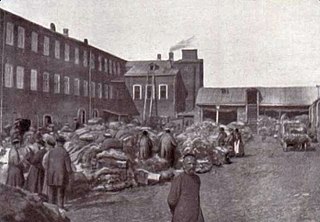
The fur trade is a worldwide industry dealing in the acquisition and sale of animal fur. Since the establishment of a world fur market in the early modern period, furs of boreal, polar and cold temperate mammalian animals have been the most valued. Historically the trade stimulated the exploration and colonization of Siberia, northern North America, and the South Shetland and South Sandwich Islands.

During his residence at Little Rapids, in 1805, he was married to Elizabeth Pelagie Ainse, a half-Dakota daughter of Joseph-Louis Ainse, a British superintendent at Mackinac. In 1809, he settled in the small village of Prairie du Chien, Wisconsin, and commenced trading, on his own account, with the Indians of the Winnebago, Fox, and Sioux tribes. In addition to that, he conducted an exchange of lead with Julien Dubuque, at the point now occupied by the city of that name.
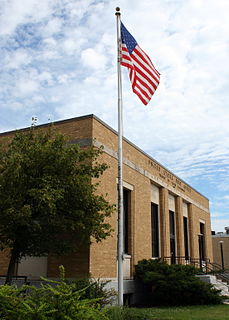
Prairie du Chien is a city in and the county seat of Crawford County, Wisconsin, United States. The population was 5,911 at the 2010 census. Its Zip Code is 53821.
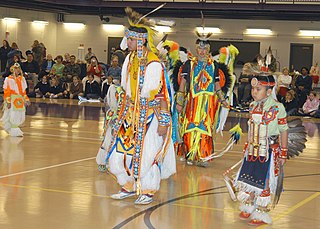
The Ho-Chunk, also known as Hoocąągra or Winnebago, are a Siouan-speaking Native American people whose historic territory includes parts of Wisconsin, Minnesota, Iowa, and Illinois. Today, Ho-Chunk people are enrolled in two federally recognized tribes, the Ho-Chunk Nation of Wisconsin and the Winnebago Tribe of Nebraska.

Julien Dubuque was a French Canadian of Norman origins from the area of Champlain, Quebec who arrived near what now is known as Dubuque, Iowa – which was named after him. He was one of the first European men to settle in the area. He initially received permission from the Meskwaki Indian tribe to mine the lead in 1788. Subsequently the Spanish confirmed that by giving him a land grant in 1796.

During the War of 1812, Faribault refused to enlist in the British army, and suffered imprisonment and the loss of all his goods in consequence. After the conclusion of the war, in 1815, he became a citizen of the United States, and recommenced his trade at Prairie du Chien. In 1819, he removed to Pike Island in the Mississippi River, which his wife received ownership of under an 1820 treaty, [2] and in 1826 to St. Peter (Mendota, Minnesota), opposite the military post of Fort Snelling. There he remained until the last years of his life, which were spent with his children in the town of Faribault, Minnesota, which is named for his eldest son. Faribault County in southern Minnesota was named after Jean-Baptiste. [3]

The War of 1812 was a conflict fought between the United States, the United Kingdom, and their respective allies from June 1812 to February 1815. Historians in Britain often see it as a minor theater of the Napoleonic Wars; in the United States and Canada, it is seen as a war in its own right.

The United States of America (USA), commonly known as the United States or America, is a country composed of 50 states, a federal district, five major self-governing territories, and various possessions. At 3.8 million square miles, the United States is the world's third or fourth largest country by total area and is slightly smaller than the entire continent of Europe's 3.9 million square miles. With a population of over 327 million people, the U.S. is the third most populous country. The capital is Washington, D.C., and the largest city by population is New York City. Forty-eight states and the capital's federal district are contiguous in North America between Canada and Mexico. The State of Alaska is in the northwest corner of North America, bordered by Canada to the east and across the Bering Strait from Russia to the west. The State of Hawaii is an archipelago in the mid-Pacific Ocean. The U.S. territories are scattered about the Pacific Ocean and the Caribbean Sea, stretching across nine official time zones. The extremely diverse geography, climate, and wildlife of the United States make it one of the world's 17 megadiverse countries.

Pike Island, Dakota name Wita Tanka, is an island at the confluence of the Mississippi and Minnesota Rivers in the southwestern part of Saint Paul in the Twin Cities metropolitan area of Minnesota, U.S.. The island is now part of Fort Snelling State Park. It is a portion of the 100,000 acres (400 km2) of land purchased from the Mdewakanton Sioux Indians by Zebulon Pike in September 1805. Pike's Purchase was later to become Fort Snelling, Minneapolis, and Saint Paul. The U.S. government wanted to build a fort to protect American interests in the fur trade in the region, and Pike negotiated the treaty. Pike valued the land at $200,000, but the U.S. Senate later agreed to pay only $2000.
He was much attached to the Roman Catholic faith of his childhood and presented a house for a chapel to Father Lucien Galtier, the first resident missionary in Minnesota (1840). He died at Faribault, Minnesota, on August 20, 1860.





